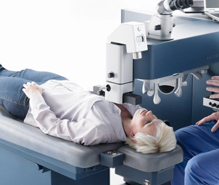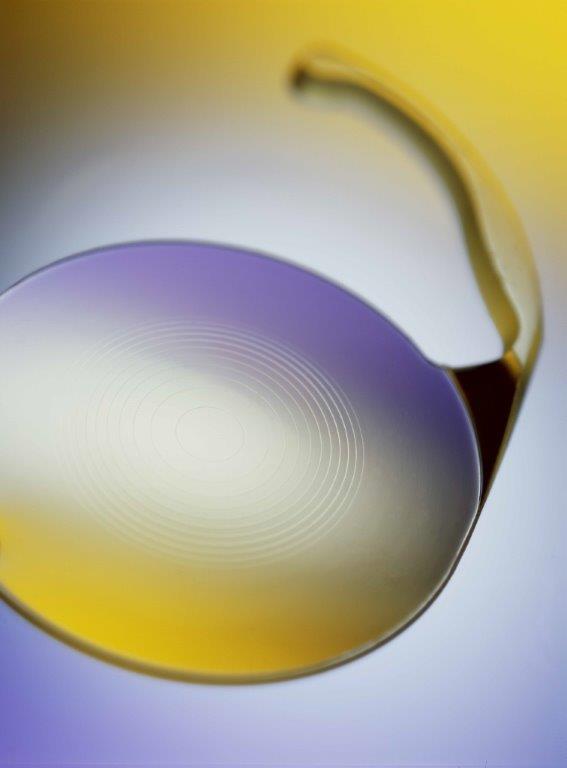A cataract occurs when the lens, which lies behind the iris about one third of the way back in the eye, becomes cloudy or opacified. This blocks light needed for vision from reaching the retina and can create symptoms of blurred vision, glare, and haloes around lights. Cataracts are painless and form slowly in most people, although it is possible for them to form quickly. In its early stages the cataract's effects may be treated with spectacles, but if your vision is affected to the point where glasses no longer help removing the cataract will usually improve your sight.
 When untreated, a cataract can continue to mature until the vision deteriorates to the point of blindness. In most situations, the vision loss from cataracts is reversible and patients enjoy improved vision soon after surgery. Cataract surgery is one of the most frequent procedures in the world, with over 3 million performed in the United States every year.
New technologies and techniques developed over the past decade have made cataract surgery very safe and successful, restoring vision and improving the quality of life of millions of patients.
When untreated, a cataract can continue to mature until the vision deteriorates to the point of blindness. In most situations, the vision loss from cataracts is reversible and patients enjoy improved vision soon after surgery. Cataract surgery is one of the most frequent procedures in the world, with over 3 million performed in the United States every year.
New technologies and techniques developed over the past decade have made cataract surgery very safe and successful, restoring vision and improving the quality of life of millions of patients.
 You may notice a gradual painless blurring of vision, double vision in one eye or fading and yellowing of colors. In some the symptoms develop so slowly one has no perception of the vision deteriorating; in others the visual disability may be very bothersome. Glare or sensitivity to bright light is commonly caused by cataracts, and may cause difficulty with driving at night. Frequent changes to your glasses or contact lens prescriptions may also be a symptom of cataract. There are no drugs or exercises that will make a cataract disappear or improve. The only definitive way to correct a cataract that is causing significant visual impairment is to remove the cataract with surgery, and replace the lens with a new one. If a cataract is affecting your vision enough to interfere with your daily activities, you should consider cataract surgery.
You may notice a gradual painless blurring of vision, double vision in one eye or fading and yellowing of colors. In some the symptoms develop so slowly one has no perception of the vision deteriorating; in others the visual disability may be very bothersome. Glare or sensitivity to bright light is commonly caused by cataracts, and may cause difficulty with driving at night. Frequent changes to your glasses or contact lens prescriptions may also be a symptom of cataract. There are no drugs or exercises that will make a cataract disappear or improve. The only definitive way to correct a cataract that is causing significant visual impairment is to remove the cataract with surgery, and replace the lens with a new one. If a cataract is affecting your vision enough to interfere with your daily activities, you should consider cataract surgery.
 Cataract surgery is performed as an outpatient procedure at a day surgery center. The procedure is done under local anesthesia with intravenous sedation, and typically takes 20-30 minutes. You should plan about 3 hours on your surgery day to check in, fill out paperwork, have your procedure, and recover before discharge. During the surgery the cloudy cataract is removed and replaced with an acrylic lens to give the eye proper focusing power. Often the vision is not only of a better quality after surgery, but patients also may enjoy a reduction in their glasses prescription. In most cases, the improvement in the patient's vision is significant.
Cataract surgery is performed as an outpatient procedure at a day surgery center. The procedure is done under local anesthesia with intravenous sedation, and typically takes 20-30 minutes. You should plan about 3 hours on your surgery day to check in, fill out paperwork, have your procedure, and recover before discharge. During the surgery the cloudy cataract is removed and replaced with an acrylic lens to give the eye proper focusing power. Often the vision is not only of a better quality after surgery, but patients also may enjoy a reduction in their glasses prescription. In most cases, the improvement in the patient's vision is significant.
Schedule a consultation with Aaron Florkowski, M.D. today. This extensive evaluation is typically covered by your medical insurance policy and will determine if you are a candidate for the procedure and the success you should expect afterwards.
During your examination, Dr. Florkowski will:
• Determine the extent the cataract has blurred your vision
• Take measurements of the shape and dimensions of your eye with optical imaging and ultrasound
• Examine the health of your eye including the cornea, optic nerve and retina
• Discuss your candidacy for the cataract procedure including your options for different intraocular lenses
You will be seen for your post-operative exam the day after your surgery. By this point you will likely notice significantly improved vision; however regardless of how well you see, it is important that you keep all of your follow up appointments to assure proper healing. These follow-up visits are typically one day, one week, one month, three months, and one year after cataract surgery.
Perhaps you have more questions on Cataract Surgery so we have provided an additional link.
 Cataract surgery continues to evolve and improve each decade. Contrary to popular belief, most cataracts are not removed using lasers; rather, a process known as phacoemulsification allows cataracts to be removed with ultrasound energy. A major benefit of modern surgical techniques is the use of incisions that are the width of a few pencil tips and are self sealing, usually requiring no stitches. The cataract itself is dissolved with ultrasound and gently removed by vacuum. Once the lens has been removed, a small foldable lens is inserted and unfolds to fill the space once occupied by the lens. These intraocular lenses are the product of highly advanced engineering and are either conventional monofocal lenses or specialized toric and multifocal lenses.
Cataract surgery continues to evolve and improve each decade. Contrary to popular belief, most cataracts are not removed using lasers; rather, a process known as phacoemulsification allows cataracts to be removed with ultrasound energy. A major benefit of modern surgical techniques is the use of incisions that are the width of a few pencil tips and are self sealing, usually requiring no stitches. The cataract itself is dissolved with ultrasound and gently removed by vacuum. Once the lens has been removed, a small foldable lens is inserted and unfolds to fill the space once occupied by the lens. These intraocular lenses are the product of highly advanced engineering and are either conventional monofocal lenses or specialized toric and multifocal lenses.
Thanks to discoveries in optics, at the time of your consultation for cataract surgery you will have the opportunity to choose the replacement introcular lens that will best fit your lifestyle and expectations. With any surgical procedure, it is important for you to understand the lens options that are available to you.
In the past after a cataract was removed, a lens was inserted that improved distance vision, but eyeglasses were still needed for all other tasks. Now multifocal specialty lenses such as the Acrysof ReSTOR® can provide good distance and near vision without the need for reading glasses. When one of these special lenses is placed in your eye our goal is to provide you with a fuller range of vision for computer and reading tasks as well as distance, and to minimize your dependence on reading glasses or bifocals. The majority of patients who have chosen specialty lenses are very satisfied with their results and would recommend the procedure to their friends and family who have cataracts. Additional testing will be performed during your consultation to determine if you are a good candidate for multifocal introcular lenses, and Dr. Florkowski will discuss whether you may benefit from this exciting technology.
 Now patients with astigmatism have the option of having a toric intraocular lens implanted at the time of cataract surgery. The AcrySof® Toric lens reverses the effects of astigmatism while treating the cataract and lessens the need for glasses after the procedure. If you have astigmatism that has required eyeglasses in the past Dr. Florkowski, after examining and testing your eyes, may recommend a toric lens as an option.
Now patients with astigmatism have the option of having a toric intraocular lens implanted at the time of cataract surgery. The AcrySof® Toric lens reverses the effects of astigmatism while treating the cataract and lessens the need for glasses after the procedure. If you have astigmatism that has required eyeglasses in the past Dr. Florkowski, after examining and testing your eyes, may recommend a toric lens as an option.
The cost of cataract surgery is typically covered by most medical insurance plans. If you decide to have a specialized toric or multifocal introcular lens placed in your eye at the time of surgery, this additional cost is not covered by insurance. The cost of the lens implant may be covered by employee flex spending plans and is eligible as a health savings account expenditure. Zero down payment 0% interest financing options are also available to you for payment. Please click here to learn more.